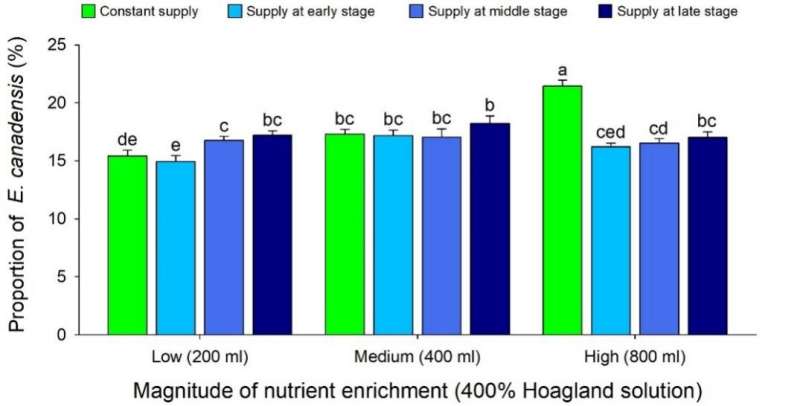Magnitude and timing of resource pulses interact to affect horseweed invasion

Erigeron canadensis (horseweed) is a serious invader in disturbed habitats and agricultural fields. It may experience nutrient pulses of different magnitudes and timings due to a variety of disturbances arising from human activities and fertilizer application on target crops. However, to date, little is known about how variations in the magnitude and timing of nutrient pluses affect E. canadensis invasion.
Researchers at the Wuhan Botanical Garden of the Chinese Academy of Sciences exposed E. canadensis and six co-occurring native plant species to three magnitudes of nutrient enrichment (low, medium or high).
For each magnitude, equivalent amounts of nutrient were added at four different timings (constant nutrient supply and supply at early, middle or late stages). The biomass production and proportion of E. canadensis biomass in a pot among different nutrient treatment combinations were compared.
According to the researchers, the impacts of nutrient pulses on E. canadensis depended on magnitude, timing and their interaction.
Under low magnitude addition, E. canadensis produced more biomass when nutrients were supplied at the middle and late stages. Under medium magnitude addition, E. canadensis produced more biomass when nutrients were supplied constantly or at the early and middle stages. Under high magnitude addition, E. canadensis produced the highest biomass when nutrients were supplied constantly and the lowest biomass when nutrients were supplied at the late stage.
Results suggest that resource fluctuation has variable effects on plant invasions rather than always promoting plant invasions.
The findings have been recently published in Oikos, titled "Magnitude and timing of resource pulses interact to affect plant invasion."
More information: Zhibin Tao et al, Magnitude and timing of resource pulses interact to affect plant invasion, Oikos (2021).
Journal information: Oikos
Provided by Chinese Academy of Sciences





















